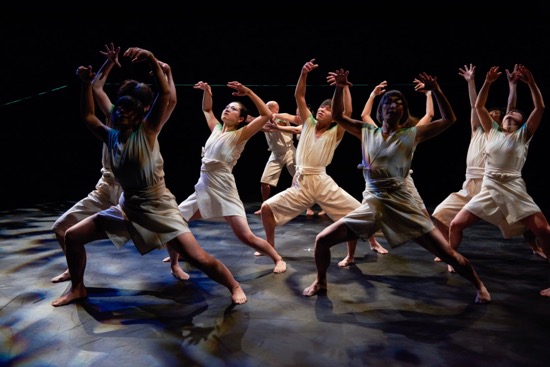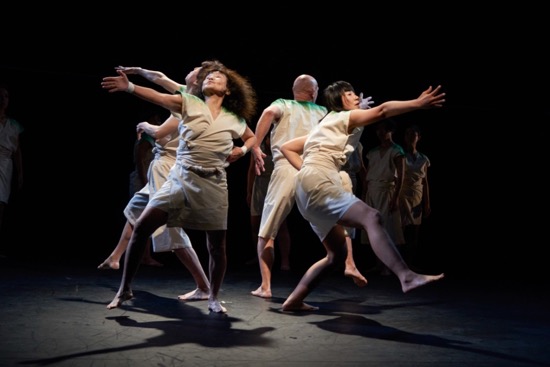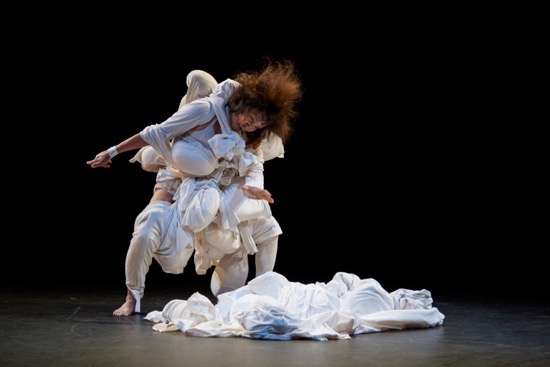Kei Takei’s Moving Earth Orient Sphere performs at New York Live Arts, January 25-27.

Kei Takei’s Moving Earth Orient Sphere in her Light, Part 44 (Bamboo Forest). Photo: Kate Enman
In 1969, New Yorkers hadn’t seen anything resembling the dances Kei Takei was beginning to make. Like the choreographers who’d been associated with Judson Church earlier in the 1960s (Yvonne Rainer, David Gordon, Steve Paxton et al), she broke the implicit rules of western dance. But in her hands, qualities such as extreme slowness and what seemed a great deal of repetition became profound: tectonic plates shifting, plants growing, rain falling for days on end. The gravity and poetry of noh drama (which she has studied) slid into the contemporary world. She called her company Moving Earth, and titled each of her dances Light. Light, Part 47 (run) premiered in Tokyo this past December.
Seventeen years ago, Takei moved back to Japan, and the company she brought to New York, as part of Lumberyard’s mini-festival at New York Live Arts, is called Kei Takei’s Moving Earth Orient Sphere. Watching Light, Part 44 (Bamboo Forest) and her solo from Light, Part 8, I remembered how amazed and mesmerized we dancegoers were by the first pieces she showed in our city. In 1970, in the small, white, brick-walled Cubiculo on way-west 54th street, one dancer (Carmen Beuchat) kept carrying in big, white, irregularly-shaped pieces of cardboard (?) and assembling them into what turned out to be a jigsaw puzzle that filled the floor; the available space for the other dancers—their earth—kept shrinking. That was Light, Part 4. In another, the performers kept taking green, tissue-paper blooms out of a basket and “planting” them in neat rows that filled the space and continued partway up the back wall. Every now and then, one of them would pause, survey the area and, as I recall, say in Japanese, “The yellow flowers are covering the field.” They stopped when their supply (which they had cut and folded themselves in preparation) ran out. A big white, obviously artificial radish was a crucial part of Takei’s 1982 solo Light, Part 16 (Daikon Fields), but the many daikons that were thrown into the space as the piece ended had been pulled from the ground not long ago.
When seeing these and later works by Takei, I often thought “daily ritual;” I thought “ordeal;” I thought “obsession.” We felt those too, especially when we saw parts 1 through 9 in the Brooklyn Academy of Music’s LePercq Space (now its café) in 1982. That performance lasted for seven hours, with breaks. Afterward, there was a party in a nearby loft.

Kei Takei’s Light, Part 44 (Bamboo Forest). Center, back to camera: Kei Takei facing Laz Brezer. Photo: Kate Enman
Takei, perhaps pressed by the exigencies of publicity for her company’s 2018 performances at NYLA (January 24 through 26), noted in the program that she was not trying to “express anything in particular” in Light, Part 44. But she mentioned in an interview that bamboo rarely flowers —maybe once in a hundred years—after which it dies. And, if you wish, you can see in the scrupulous patterns she has created for twelve dancers both gusts of wind and the stillness that comes when it subsides, the spreading roots, the clustering stalks, the falling rain. Plant some bamboo; after a while you have a grove.
The performers wear the white outfits particular to many of Takei’s dances. These are not beautiful or form-fitting. They are bulky farmer attire: loose pants for the men, short sarongs for the women, tops that are crossed and knotted. For Light, Part 44, the costumes have patches of green dye on the shoulders. The area in which these people congregate is defined by a slender wood frame, designed by Renta Kochi, that’s almost the size of the stage; it’s tilted so that its rear horizontal bar is higher than its front one. Yoshiyuki Shimizu’s lighting turns it green. In Seichiro Sou’s score, you can hear the roar of wind or waves, a light pattering of percussion, the tinkling or clanging of bells.
The dancers (eight women and four men) work low to the ground—loping, rushing, never leaping high. They perform almost every task with intense commitment, whether thrusting their arms forward or straight up, then yanking them down, whether waiting immobile or stepping firmly and rhythmically across the floor. Their focus is often on that ground, their bodies bent over, but they also gaze upward occasionally, as if sensing changes in the atmosphere. At times, they seem to gather something between their hands. At other times, they might be sowing seeds. They often divide into two units, cluster, form diagonal lines, advance, retreat.

Kei Takei’s Light, Part 44 (Bamboo Forest). Takei left front. Photo: Kate Enman
Takei is submerged in the group for most of the piece, but she begins it with a statement. Perhaps she is accustoming us to slowness. Her arms slant stiffly down, her fingers pressed together. Staring above our heads, she stretches one foot forward, turns it out, and plants its heel on the floor, puts her weight on it, then takes another step, then another. You have time to think about each one and wonder about a destination.
As the choreography progresses, it brings various performers to our attention. Laz Brezer and Mitsuko Kawarada face us, staying close together and moving in unison, their eyes fixed on something. Chio Ishida seems more vulnerable. Even when her feet are planted far apart, her knees bent, she looks as if she’s melting in tiny, private ways, recovering her equilibrium even as some new impulse (a breeze?) sways her. Her hands grope air. When she and Brezer come together, he behind her, he joins his arm to hers and pushes both straight up in such a way that, for seconds, you’re not sure which arm belongs to which of them. While everyone else remains immobile, Brezer performs a long, slow solo in a downstage corner, responding to forces we can’t see.
The picture keeps changing subtly. Maybe four dancers moving together grab our attention. Maybe we focus on couples forming and separating. The music often falls silent, but it charges the atmosphere, just as the dancers’ intent stillness suggests that they’re waiting for a change that’s bound to come. In this formalized forest, winds sweeps like tides across the stage, dies down, rises again.

Kei Takei in the solo from her 1974 Light, Part 8. Photo: Kate Enman
The fact that Takei deals with elemental forces in her work does not rule out humor. The solo from Light, Part 8, which premiered forty-three years ago in New York, is both comical and horrifying. For those unfamiliar with her work, Takei is a small woman—small and sturdy. In this, impishness—a facet of her onstage persona—comes into play.
Voices chant in Yukio Tsuji’s recorded score; after a while they seem to natter at us like mosquitos. Meanwhile, Takei jitters excitedly around a heap of white fabric, pulling items of clothing stuffed with globular shapes from it. She hurriedly puts these on, one by one, however she can manage it; a sweater sleeve may end up on her leg, a pair of tights may become a cape. She dances around the pile and hovers over it like a bee seeking honey, yanking out a garment and knotting it to whatever previously donned one is handy. Pretty soon, you realize that she will use everything in the pile, and that nothing will stop her. This, folks, is a dance about greed running rampant.
Before long, she’s too loaded down to stand up; she has to roll and somersault and stick her legs into the air in order to pursue her goal. Ever laugh and cringe at the same time? I’m doing that. In the end, the choreographer-performer is on her back, like a beetle that, once overturned, can’t right itself no matter how valiantly it waves its legs. Two stagehands pick up the bundle that Takei has become and lug it offstage.
On that note, the evening ends. Welcome back to New York, Kei. Too bad you’re not staying longer. Good luck to you and your splendid, deep-in-the-moment dancers when your company moves on to San Francisco and Washington D.C.

I saw the Kei Takei company as well and was both mesmerized and agitated. Although there is no clear message I think I’m being schooled in the art of living.
Deborah. You totally hit the mark in this review. Particularly in describing Kei’s solo and conclusions. I too was laughing with hesitation. Although maybe because I needed to be released from what was both comical and horrible to look at.
Thanks always for your visionary writing.
Great review, Deborah. I was so sad to miss this performance. Just a quick note: Kei last performed in New York at Danspace Project 17 years ago in 2001 (just a couple of months after 9/11) but she moved back to Tokyo in 1991, 27 years ago.